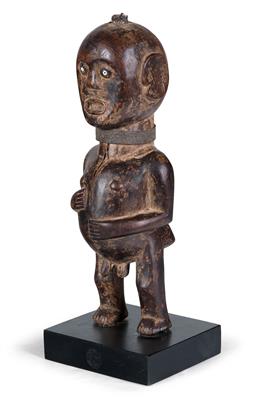Pare, Tanzania: a male power figure for protection and healing, in perfect Pare style.
Pare, Tanzania: a male power figure for protection and healing, in perfect Pare style.

The traditional eastern African art of the tribes of Tanzania, such as the Makonde, Nyamwesi, Zaramo, Kwere, Doe, Zigua, Shangaa, Pare, etc., has only recently attracted more attention and been the subject of increasingly detailed research. It is a promising field for researchers and collectors.
The present male figure displays the perfect style of the Pare, from northeast Tanzania. It is made of hard, heavy wood and dyed dark brown. The large, flat ears, almost round in shape, and the thick bald head are typical of the Pare style. The eyes are set with white glass beads, the nose is short and broad and the mouth is wide open. The small sculpture has a leather collar around its short, stocky neck. The arms lie close to the body, and are bent. Both hands rest on a well-fed, corpulent stomach. The genitals are accentuated, the buttocks are displayed to the rear, and the whole Pare man stands on relatively slender, short legs and small feet.
There is a cavity in the top of the bald head which is filled with ‘magic material’ (probably splinters of bone). The latter is supposed to provide the figure with powerful forces. This ‘charging’ (or ‘inauguration’) was probably carried out by a local ‘waganga’ (priest, healer, soothsayer) who used figures such as this one in their rituals (healing the sick, predicting the future etc.).
A classic example of a small sculpture of the East-African Pare tribe, with only one small piece missing to the back of the head and minimal traces of earlier insect damage to the neck and chest. Otherwise, no damage. General scuffing of colour and a good, shiny patina reveal that this figure has been used over a prolonged period of time, and is correspondingly old. There is an inventory number from a collection, in white letters, on the outside of the right foot.
Height: c. 30 cm; width: 10.7 cm. First half of the 20th century.
Provenance: South African private collection.
Lit.: ‘Tanzania’ by Marc L. Felix and Maria Kecskési, ill. p. 155, 189; ‘Shangaa. Art of Tanzania’ by Gary van Wyk, ill. p. 172, 173; ‘Glaube, Kult und Geisterwelt’ by Ralf Schulte-Bahrenberg, p. 63, ill. 6
Expert: Prof. Erwin Melchardt
 Prof. Erwin Melchardt
Prof. Erwin Melchardt
+43-1-515 60-465
erwin.melchardt@dorotheum.at
06.04.2017 - 15:00
- Dosažená cena: **
-
EUR 750,-
- Vyvolávací cena:
-
EUR 600,-
Pare, Tanzania: a male power figure for protection and healing, in perfect Pare style.
The traditional eastern African art of the tribes of Tanzania, such as the Makonde, Nyamwesi, Zaramo, Kwere, Doe, Zigua, Shangaa, Pare, etc., has only recently attracted more attention and been the subject of increasingly detailed research. It is a promising field for researchers and collectors.
The present male figure displays the perfect style of the Pare, from northeast Tanzania. It is made of hard, heavy wood and dyed dark brown. The large, flat ears, almost round in shape, and the thick bald head are typical of the Pare style. The eyes are set with white glass beads, the nose is short and broad and the mouth is wide open. The small sculpture has a leather collar around its short, stocky neck. The arms lie close to the body, and are bent. Both hands rest on a well-fed, corpulent stomach. The genitals are accentuated, the buttocks are displayed to the rear, and the whole Pare man stands on relatively slender, short legs and small feet.
There is a cavity in the top of the bald head which is filled with ‘magic material’ (probably splinters of bone). The latter is supposed to provide the figure with powerful forces. This ‘charging’ (or ‘inauguration’) was probably carried out by a local ‘waganga’ (priest, healer, soothsayer) who used figures such as this one in their rituals (healing the sick, predicting the future etc.).
A classic example of a small sculpture of the East-African Pare tribe, with only one small piece missing to the back of the head and minimal traces of earlier insect damage to the neck and chest. Otherwise, no damage. General scuffing of colour and a good, shiny patina reveal that this figure has been used over a prolonged period of time, and is correspondingly old. There is an inventory number from a collection, in white letters, on the outside of the right foot.
Height: c. 30 cm; width: 10.7 cm. First half of the 20th century.
Provenance: South African private collection.
Lit.: ‘Tanzania’ by Marc L. Felix and Maria Kecskési, ill. p. 155, 189; ‘Shangaa. Art of Tanzania’ by Gary van Wyk, ill. p. 172, 173; ‘Glaube, Kult und Geisterwelt’ by Ralf Schulte-Bahrenberg, p. 63, ill. 6
Expert: Prof. Erwin Melchardt
 Prof. Erwin Melchardt
Prof. Erwin Melchardt
+43-1-515 60-465
erwin.melchardt@dorotheum.at
|
Horká linka kupujících
Po-Pá: 10.00 - 17.00
kundendienst@dorotheum.at +43 1 515 60 200 |
| Aukce: | Mimoevropské a domorodé umění |
| Typ aukce: | Salónní aukce |
| Datum: | 06.04.2017 - 15:00 |
| Místo konání aukce: | Wien | Palais Dorotheum |
| Prohlídka: | 01.04. - 06.04.2017 |
** Kupní cena vč. poplatku kupujícího a DPH
Není již možné podávat příkazy ke koupi přes internet. Aukce se právě připravuje resp. byla již uskutečněna.
